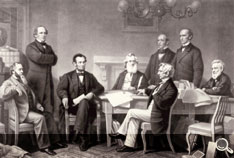

The Emancipation Proclamation
Lincoln's Emancipation Proclamation dramatically changed the meaning of the war by declaring that all persons held as slaves in states still in rebellion were "thenceforward, and forever free." Northern blacks largely welcomed the Proclamation by enlisting in record numbers, providing by war’s end more than 185,000 soldiers and sailors for the Union cause. Although the Emancipation Proclamation did not free slaves in the border states and exempted Union-occupied areas in the South, it effectively transformed advancing Union forces into armies of emancipation. Lingering reservations about the legality of this executive order convinced Lincoln that only a constitutional amendment would permanently guarantee black freedom after the war.
Alexander Hay Ritchie print of Francis Bicknell Carpenter's heroic painting of First Reading of the Emancipation Proclamation of President Lincoln. Photograph courtesy of the Abraham Lincoln Presidential Library and Museum.
This 1864 decorative printing of the Emancipation Proclamation illustrates the horrors of slavery. Photograph courtesy of the Abraham Lincoln Presidential Library and Museum.
Lincoln signed the Emancipation Proclamation in the Executive Mansion on January 1, 1863. The document was published in newspapers and reproduced in dozens of decorative designs. A limited edition of forty-eight copies signed by Abraham Lincoln sold for ten dollars each at the Great Central Sanitary Fair in Philadelphia from June 7 to 29, 1864.
Leland-Boker Draft Printing of the Emancipation Proclamation
This draft printing of twelve souvenir copies was the forerunner of the forty-eight copies that were signed by Abraham Lincoln, Secretary of State William Henry Seward, and presidential secretary John G. Nicolay. The money raised by the sale of the final printings went to the United States Sanitary Commission for medical supplies.
Download text transcript of document (.pdf)
Download image of document (.pdf)


